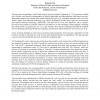Free Online Productivity Tools
i2Speak
i2Symbol
i2OCR
iTex2Img
iWeb2Print
iWeb2Shot
i2Type
iPdf2Split
iPdf2Merge
i2Bopomofo
i2Arabic
i2Style
i2Image
i2PDF
iLatex2Rtf
Sci2ools
125
Voted
IEEESCC
2005
IEEE
2005
IEEE
Web Services Composition: A Story of Models, Automata, and Logics
eal world”, represented abstractly using (time-varying) first-order logic predicates and terms. A representative composition result [11] here uses a translation into Petri nets. The “Roman” model for [4] focuses on an abstract notion of “activities” (without modeling how they impact the world), and in essence model web services as finite state automata with transitions labeled by these activities. A powerful composition result is obtained using a reduction to Propositional Dynamic Logic (PDL). The Conversation model [5] focuses on messages passed between web services, and again uses finite state automata to model the internal processing of a service, with transitions labeled by message sends and message reads. A key result here concerns determination of the “local” behavior of individual services, if they are required to conform to a given “global” behavior (as might be specified using choreography constraints, reminiscent of WS-Choreography [17]). The talk also discu...
Related Content
| Added | 25 Jun 2010 |
| Updated | 25 Jun 2010 |
| Type | Conference |
| Year | 2005 |
| Where | IEEESCC |
| Authors | Richard Hull |
Comments (0)

